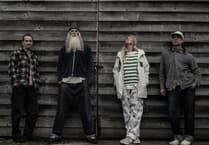What is it about Tenby? Is it the warm sea wind, the sounds of herring gulls and oyster catchers, or is it the view from High Street, looking through enchanting flower beds past majestic fertile cliffs and golden sand to the sparkling blue sea, populated with bright boats and children at play?
Or perhaps it is the gentle pace of life within the ancient walled town; the pastel shades of harbour houses jostling a place at the foot of Castle Hill; the imposing fronts of Georgian hotels along the Esplanade and the Croft. Whatever your favourite aspect of Tenby, you will be as enthralled with 'the jewel in Pembrokeshire's crown' as the painter Augustus John, who was born in the town and remarked:
"You may travel the world over, but you will find nothing more beautiful: It is so restful, so colourful and so unspoilt."
Take a walk round historic Tenby...
Start at our museum, on the Castle Hill, where all our history is to be found - but with never a dull moment. It is well known as one of Britain's outstanding museums, with an impressive art gallery. It is housed in the remains of our castle and to get to it you pass through the ruins of the barbican gateway. The museum is open every day in the summer season, from 10 am to 5 pm, Monday to Friday in the winter months.
Castle Hill
After your visit, go out on to the hill. On the top is the old castle keep - now a weather station. There is also the old Coastguard House, and the Welsh national memorial to 'Albert the Good, Consort of our beloved Queen Victoria'. Nearby, sea poetry ranging from Horace to Dylan Thomas is interpreted by Jonah Jones's striking mosaic mural. Below is the bandstand, a replica of the Victorian one which was sacrificed for essential metal during World War II.
Further round you pass the steps which led to the Royal Victoria Pier, sadly demolished in the '50s, which is why you have to disembark at low tide by a precarious landing stage in the shelter of St. Catherine's Rock. The empty fort, by the way, is also Victorian. It never fired a shot in anger, was later converted into a sumptuous private residence and has even been used as a zoo!
You cannot miss the lifeboat house and launching slip. We have had a lifeboat for over 150 years; go in and see the RFA Sir Galahad and the record of volunteers, for many a long family tradition of service. Carry on round, past a portion of what was castle wall and emerge into Castle Square. The white house with a Greek inscription over the door was built at the beginning of the 19th century as baths and assembly rooms, in the tradition of the inland spas, but here the waters were salt! However, as the Greek translates: 'The sea washes away all the ills of men'.
You can, if you choose, buy one of the trail guides or join a conducted tour and take in the town in one gulp, but if you do not have the time for that, do look around you; wherever you happen to be it will add to your enjoyment.
The Harbour
You will certainly visit the harbour. The stone quay dates back to the 1300s and was one of the earliest in Wales. Mediaeval Tenby was prosperous; visit the Tudor Merchant's House and see how well they lived. The quay was originally curved to give greater shelter, but had to be straightened in the 19th century to give access to larger ships. This meant the demolition of the ancient chapel which stood on the end. To replace it, St. Julian's Church was built in 1874. Still used today for various services, including ones involving all the churches of Tenby, it was once where the fishermen would pay their tithes of fish to the church.
Today the harbourside is the scene for many events during the summer. In addition to the Sunday evening open-air services with the Salvation Army, there are regular performances by Tenby Male Voice Choir and Tenby and District Brass Band. An opportunity to sample freshly made paella is one of the many typical special events that have become part of Tenby's colourful tradition, while the 'Spectacular' regattas highlight the end of July and the middle of August.
In Nelson's footsteps
If you walk up St. Julian's Street when you leave the harbour, look at the elegant houses of Lexden Terrace, built in the 1830s. Following the ravages of civil war and plague, Tenby began its resurgence as a resort in the late 1700s. The earliest houses of quality in this part of the town were East Rock House and Little Rock House next to it, built by the Greville brothers, sons of the Earl of Warwick and nephews of Sir William Hamilton. In 1802 you could have seen Sir William, accompanied by his wife Emma and Lord Nelson, walking up to the theatre in Upper Frog Street, with the bells of St. Mary's ringing out a welcome to the naval hero.
They will not have walked through the open space of Tudor Square you see now. It was then a triangle of cottages and markets and a hive of activity. They all came down in the 1830s as part of the Tenby Improvement. Further up the High Street there were houses on both sides; those backing on to the church came down at the same time.
The church, the gaol
and Tudor Square
Do go into the church, which reflects both the Early English and Perpendicular styles. It is one of the largest and finest in Wales. The earliest parts of the building are over 800 years old and the octagonal spire reaches 152 feet high. The two arches to the west are thought to be the remains of St. Mary's College, a Carmelite convent, established in 1399.
To the right of the altar steps is the tomb of Thomas White, whose services to a future king became legendary. After a defeat in the Wars of the Roses, Jasper Tudor, Earl of Pembroke, escaped with his 14-year-old nephew Henry, to Tenby, from where they sailed to Brittany. Fourteen years later, in 1485, Henry returned to Pembrokeshire and, gathering an army on the way, defeated King Richard III at Bosworth Field and, as Henry VII, was our first Tudor King. At the time of the escape from Tenby, Thomas White was Mayor and he is credited with having concealed the fugitives in the cellar of Jasperley House, more familiar today as 'Boots'. The cellar runs under the High Street to the corner of the churchyard gate.
By the way, Tudor Square is not named after that event, but after the Tuder family, who lived there - the council clerk got the spelling wrong. On Café Culture day, instituted two years ago to an enthusiastic response, Tudor Square is turned into a continental street café.
Behind the church is St. George's Street, leading to the Five Arches. Next to the churchyard gate are some bars with a slate tablet saying that the gaol was nearby; its door was a little further on. The barred and raised piece was originally the main path to the church and round to the High Street.
The gaol was beneath the medieval Guildhall, where justice was meted out, so culprits had not far to go - 'down the 11 steps'... you can see where they were from inside the churchyard.
Walking the walls
You enter the Five Arches through what was the gateway, and the arch to your right still has the slots in which the iron portcullis was raised and lowered. The other arches were opened much later, when the tower was no longer needed for defence, to ease traffic flow. The Five Arches is now internationally recognised as the symbol of the Walled Towns Friendship Circle, incorporating over 130 towns from 22 countries.
If you look to the right along the length of the South Parade, with its shady trees, you will see a tower with open sides which gives access through an arcade into Upper Frog Street. The apertures were originally made in 1784 by Michael Morris to give a long straight run for the manufacture of ropes - a 'rope walk'. The separate strands were twisted into rope with a windlass which stood outside the portcullis gate. The rope walk can be seen in sketches by Charles Norris, who lived near the Tudor Merchant's House.
The arcade leads you to the market. Don't miss this - apart from shopping you can enjoy a coffee while studying Eric Bradforth's brilliant mural of the history of Tenby. There is a key diagram to help you sort it all out.
Round the corner tower at the top of South Parade, the wall now ends at Upper Frog Street; it once went on to the sea, with a great North Gate; the main entrance to the town. It was removed in the 18th century to open the road for easier access. To celebrate the new millennium, building a new ornamental North Gate was suggested, but plans were never implemented.
North Town
The Norton, down the hill, was North Town, originally the only extension outside the town walls, in the direction of Carmarthen. The right fork from The Norton, along the sea front, takes you on to The Croft; an elegant mid-Victorian terrace from which you get that much sketched, painted and photographed view into the harbour, fringed with pastel houses and with the Castle Hill behind.
It was while on holiday at No. 2, The Croft, that Beatrix Potter wrote letters to her governess, illustrated with little drawings of what was later to become Peter Rabbit.
At other times you might have met other literary ladies. Jane Austen knew Tenby and one Mary Ann Evans, lodging in Bridge Street, woke one morning inspired to write a novel. She chose, as a pen name, George Eliot. Perhaps they will encourage you to raise your 'wish you were here' cards to new heights.
Remember also to visit the Tourist Information Centre here.
South side
Going along from the Five Arches in the other direction, towards the sea, the first tower has a house inside. The next one, large and square, was built after guns started to take over from bows, with keyhole ports for the weapons. Just before it is a larger port to take a cannon and, above that, a garderobe (lavatory). Originally there would have been a moat underneath.
The large opening beyond, giving access to this end of the town, is the Belmont Arch. The very end tower was the last addition to the wall; look over and you will see why. It goes a long way down and building it was a problem but, without it, the corner was a weak spot.
The Paragon
If you pass through the Belmont Arch, you can follow on, via Tor Lane/Cob Lane back to Tudor Square and the harbour or, at the far end of The Paragon, down the Iron Bar steps to the beach - the bar is now only a memory and a name. The railing on The Paragon is a good spot to watch the breakers on a full tide and a windy day. Don't get carried away; a runaway horse once went over here, milk float and all. The little public garden below was once the site of the town battery, hence the name Gunfort. You will find a nice little story about John Paul Jones and his ship in the guide books.
The Esplanade
Outside the Belmont Arch again there is The Esplanade, overlooking the South Beach to Giltar Point, with Caldey for a backdrop - don't miss a walk along the cliffs.
The south cliff was planned and developed in the 1860s, when the opening of the through railway to Tenby created a new demand for accommodation, from fine residences to lodging houses. Take a look at the Atlantic Hotel. Warren de la Rue, of the printers of bank notes and playing cards, converted two of the houses into his residence. The horse's head over the door represents Trayles, his Ascot Gold Cup winner.
The Esplanade is a fine elevated promenade with views of the dawn over the Gower coast and sunset behind the Ridgeway over Penally. On a clear day you can see Ilfracombe, but Lundy Island is concealed by Caldey. On your cliff walk you can see it on the horizon, when it is clear enough. The house on the corner of Victoria Street, now part of the Belgrave Hotel, is where the artist Augustus John was born and a plaque on No. 32 Victoria Street shows where he and his now even more prestigious sister, Gwen, were brought up. Their first art teacher lived nearby.
...Or just enjoy yourself
With its four award-winning sandy beaches, each offering sunshine and shelter at different times of day, there is plenty of scope for every activity, without having to travel to find it. There are three beach cafés, each with facilities nearby, and shops selling beach equipment, souvenirs and ice-cream abound. A whole range of water pursuits is catered for, including surfing, yachting, kayaking and novelty rides.
Boat trips can be booked on the harbour - take the 20-minute trip over to Caldey Island, or enjoy a peaceful cruise in the bay or 'round the island'.
If golfing is your forte, you will love the 18-hole links course, complete with clubhouse and shop, situated behind the South Beach dunes.
Ideal for wet weather days, Tenby Leisure Centre provides a swimming pool, sauna, solarium and jaccuzi as well as sports hall, fitness room and air-conditioned dance studio.
The De Valence Pavilion is the venue for various special events, while the nearby cinema provides films nightly.
In July, Tenby bursts into flower and is a consistent winner of the Wales in Bloom trophy. In September it is into music and song during the annual Tenby Arts Festival. But pay a visit in the winter sometime, and you will discover a secret: Tenby is gorgeous all year round!




